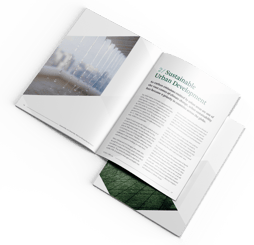Investors and investment managers are increasingly focusing on developing and embracing tools and techniques to better assess climate risk and resilience at both asset, portfolio, and market level. Going forward, markets with a proactive approach and a continuous focus on sustainability and climate risk mitigation strategies will be frontrunners in terms of attractiveness as investment destinations. This implies that, in the future, assets and locations that are considered less affected by climate change or more resilient to it could well benefit from pricing premium.
Since risks associated with climate change can have substantial financial implications, the number of investors and investment managers that are developing a proactive approach to address climate risk is increasing. Physical risks, such as extreme weather conditions, flooding and storms, can result in upward pressure on insurance premiums, higher CAPEX and OPEX, as well as a decrease in the liquidity and value of buildings. On the other hand, transitional risks (including economic, political, and societal response to climate change) can lead to a decrease of the appeal of metropolitan areas and in worst cases, individual assets becoming obsolete. Current market praxis has not many examples of investors’ pulling back from entire markets completely because of climate risks. But following investors’ increased understanding of climate risks, their investment decisions will become more climate-conscious.
An important consideration is the ability to distinguish the potential impacts of climate risks on asset, portfolio, and market level. While sustainability largely focuses on operations, climate risks can ultimately have a greater effect on property valuations. The objective is to understand how climate risks could affect asset liquidity and, as a result, returns in both income and capital growth.
Pricing climate risk and resilience is far more complex than pricing energy efficiency and carbon reduction. There is a general understanding that the commercial real estate industry needs standardisation of the ‘currency of risk’. Because measuring something first requires the variable to be defined. And this is what is very challenging. There is an impact on the property level, an impact on the related infrastructure that property depends on and a market impact. If a whole neighbourhood is flooded and your property is up on a hill, you might be ok in terms of damages, but you are to take a hit in terms of property’s ability to function, impacting thus its value.
Climate risk mapping tools will increasingly be used to screen current assets, portfolios, and potential new acquisitions. These tools will allow investors to gain a better perspective of the risk profile and exposure of each asset and portfolio. Based on the data, vulnerable areas can be selected and, through further due diligence, determine if risk factors have been mitigated at property and market level. For assets flagged as high risks, further due diligence process might assess the need for additional CAPEX, which then will be reflected in property valuation. Ultimately, operational risk can result in lower valuations, which is particularly important for investors considering longer time horizons.
In this report, CBRE is looking at the equation between sustainable urban planning, climate risks and real estate investment flows. In the Nordic, both historical legacies and future strategies are securing a solid foundation for ensuring the commercial real estate market’s robustness. A resilience approach applied across the Nordic region focuses on how to build capacity to deal with unexpected change, allowing for a more successful mitigation of future impacts. This is believed to further strengthen the overall attractiveness of the region as an investment destination. These learnings can provide other key urban locations across Europe with best practices, which they may consider implementing.
Download the full report here >>



